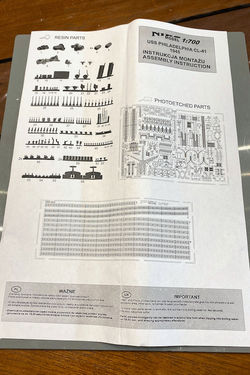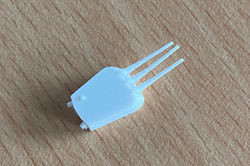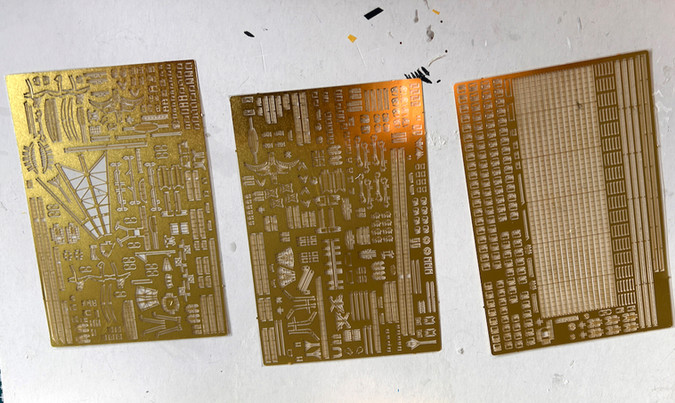 |  |  |
|---|
Click on a picture in the gallery above to see a full resolution image, or to navigate manually
HNLMS De Ruyter (C801).
North Atlantic, 1953
Why this ship?
To put it simply, I consider this Dutch Cold War-era cruiser one of the best-looking ships ever. The fact that she survived to be the last all-gun cruiser in service anywhere in the world (following transfer to the Peruvian Navy, as the Almirante Grau) adds some historical significance.
Demonstrating once again that we amidst a golden age in scale modelling, we can now get a kit of what would be normally a very niche subject. The kit is from Doggy Industries (who defined themselves as "a small workshop operated by Liu and his friends in part time").
What was added
This was essentially an out-of-the-box build. Other than paint and cyanoacrylate glue, all I needed to add was rigging, which was done with Uschi elastic thread. This choice of rigging material was important in this case, as the masts are really fine, and any less elastic line would pull them out of shape. A sea base was also added using the same technique I learned when building the 1/700 HMS Eagle.
Lessons learned and problems circumvented
-
The out-of-the-box aspect was made an easy choice by the comprehensive nature of the kit. In addition to the resin parts, it comes with 3 extensive frets of photoetch parts, metal barrels for the main guns, and decals for pennant numbers and flags. Not being one that hesitates in adding my own touches, in this case it was hard to find something that needed adding.
-
I will not mince words here when I say that this kit set for me a new standard for what to expect in terms of photoetch. The detail is fine, yet the metal is easy to cut with a standard scalpel blade, and to work with. Every single door and hatch is represented as a separate part, and can be modelled open or closed. Every single vent is there. Forget about generic railing: every section is individually numbered, and has clear bend marks which fit precisely in the place it is meant to go. And what is more, insofar as I could find from the photos available online, every detail represented is accurate. The amount of research that seems to have gone into this kit is mind-boggling. Sure, building this kit means having to position, and in many cases bend, dozens of sub-millimetre parts - but the result is satisfying.
-
The photoetch is also impressive in terms of the number of spare parts you get. All common offers to the carpet monster are there, so the level of stress in the build was much reduced: why spend hours on your knees with a magnifying glass and a lamp, when you can just to to the "general parts" sections of the frets and get a new part? There is also enough spare railing for another ship. In summary, on the basis of the photoetch alone, I felt that I got my value for money.
What you get out of the box: Images 1 and 2: The components come in good packaging, with the small parts in individual zip lock bags, the photoetch frets in sturdy plastic sandwich backing, and the whole lot supported by foam to minimise shaking during transportation. Image 3: three photoetch frets. Most of the railing you see on the right side fret is spare. Image 4: some of the resin sprues after unpacking.
- Having talked about the positives, now a few caveats. The resin parts are sharp and detailed in general, but need some work to bring them to the same level as the photoetch. I had three types of problems, two which were solved satisfactorily, and one not so well.
- First, there was some oblique patterning in large parts, like the hull, which was hard to eliminate, even after multiple layers of Mr. Surfacer. This is hard to capture in the camera, but the image below will give you some idea of what I mean. Nothing that some sanding can't fix, right? But the resin was noticeably harder to work with, for example, in comparison with those in Niko Model's USS Philadelphia. Yet, in the end, more robust sanding did fix the striping.
- But this leads me to the second issue. The tough nature of the resin also meant that it was impossible to reshape parts, when required. Don't get me wrong, most parts were good enough. But there was a terribly bent part of the aft superstructure which, despite multiple immersions in hot water and strong clamping, never managed to fit well.
The least satisfactory issue with this build: Level 2 of the aft superstructure could not lay flat. This image shows the result of trying to join the front part; note the visible gap at the back. Immersion in hot water never managed to fix this problem, and strong clamping only helped to a little extent. Unfortunately, the use of filler was also difficult at this stage, after application of all doors, vents and hatches. If I ever tried this again (famous last words...) I would have glued all parts of the superstructure together first, before applying all photoetch.
-
The third problem was that the kit came one part short of the number required. Specifically, there were 7 copies of part R4 (the base of the 40mm Bofors mounts), instead of 8. I am happy to report that contacting Doggy Industries through their Facebook page got me a prompt reply, and the missing part was quickly sent from China free of charge.
-
I could not find accurate records of the appropriate paints used by the Dutch Navy in the 1950's. The few colour images that made to this day suggest a very light grey with some blueish tint for the vertical surfaces, and dark greenish grey for horizontal surfaces. To make things more complicated, none of the images I found was from above. Therefore, some guesswork was required.
-
In the end, I felt that it was reasonable to use airbrushed SMS Light Admiralty Grey (PL169) for the hull and vertical surfaces. This turned out to be a lucky choice because it could be touched up when necessary with a paintbrush, using AK Air 3rd get ADC Grey (the difference being imperceptible).
-
For horizontal surfaces, the choice was airbrushed Mr. Color 36 (grey green).
-
Click on a picture in the gallery above to see a full resolution image, or to navigate manually
In summary:
This being only my second resin kit, my only comparison was with the Niko Model's USS Philadelphia. They each have their advantages and disadvantages.
-
Niko's resin is smoother, and easier to work with, which helps with both painting and getting things to fit. Doggy Model's resin is harder to work with, and in the rare case when the fit is not good, the result is less satisfactory. But, on the positive side, it come with a lot less flash.
-
The Instructions were clearer better here. Even when I found myself scratching my hear to figure something out, there was a picture somewhere that made things, if not clear, at least possible. In comparison, Niko's instructions required a lot more trial and error.
-
But where this kit shines really is in the photoetch. Even though I was quite happy with Niko's set provided for the Philadelphia, this one blows any competition out of the water in terms of precision and ease to use (well, at least, as easy as it can be made folding or manoeuvring into place tiny pieces of metal). And, the plentiful spares...
This is a challenging kit, but in a positive way. Definitely for experienced modellers only, but highly recommended.


Construction photos
 |  |  |  |  |  |
|---|---|---|---|---|---|
 |  |  |  |  |  |
 |  |  |  |  |  |
 |  |
Click on a picture in the gallery above to see a full resolution image, or to navigate manually
-
The kit comes in a sturdy open top box.
-
The packaging is robust, preventing small resin pieces from being lost.
-
Page 1 of instructions with the parts map. Note a separate photo etch fret for railings, with plenty of spares. Some of the more delicate resin parts (like AA guns) also come with a few spares.
-
Page 2 of instructions.
-
Page 3 of instructions.
-
Page 4 of instructions.
-
The resin parts as they come out of the box. There is a quite a bit of flash everywhere (e.g. yellow arrow). Fortunately this proved easy to remove.
-
The metal parts as they come from the box. The wire is meant to become the thinner parts of the upper mast. I ended up using tungsten wire, which was straighter.
-
Detail of the forecastle; the decking is represented in fine detail.
-
Detail of midships.
-
Detail of the hull as it comes out of the box. Several issues here. There is some excess resin that needs sanding, the representation of the armoured belt is exaggerated, and there are no portholes.
-
The main part, after problems remedied by sanding, and drilling.
-
First round of painting. The sides of the hull were done (dark sea blue first, haze grey after masking). Then this was covered with Tamiya clear, and masked to allow the application of deck blue. Finally, the vertical surfaces above the deck, by paintbrush. The deck blue was subsequently "weathered" a bit using Tamiya panel line accent (brown) and then wiping most of it out with lighter fluid.
-
Step 1 in the construction of a twin Oerlikon 20 mm mount. Each comes flat as a single photoetch piece.
-
Step 2 in the construction of a twin Oerlikon 20 mm mount. First bend forms the shield.
-
Step 3 in the construction of a twin Oerlikon 20 mm mount. Bend gun barrels over the shield, then the handles.
-
Resin parts often come out of shape. As part of my new skills, I learned how to use hot water and gentle manipulation to remedy problems like this...
-
After adding the superstructure and stacks. The hardest part of this build was securing the main mast, and making sure it was vertical. The instructions were pretty vague with respect to where exactly it had to be inserted. Even after a lot of dry fitting, it was still wrong, requiring me to disassemble the back part of the fore structure, and re-paint. I am still not 100% sure that I did it as it was meant to be, but my solution does not look too far from what I can see in pictures of Brooklyns. By this stage I had added some of the AA guns. My advice: don't, wait until the end. I broke many of them, which had to be repaired or replaced.
-
A few more details added. The aft mast was a lot easier to figure out.
-
Finally - after the railing, rigging, other gun mounts and the catapults. All capped with a coat of SMS flat clear.












